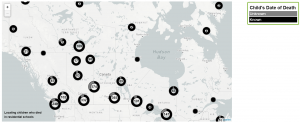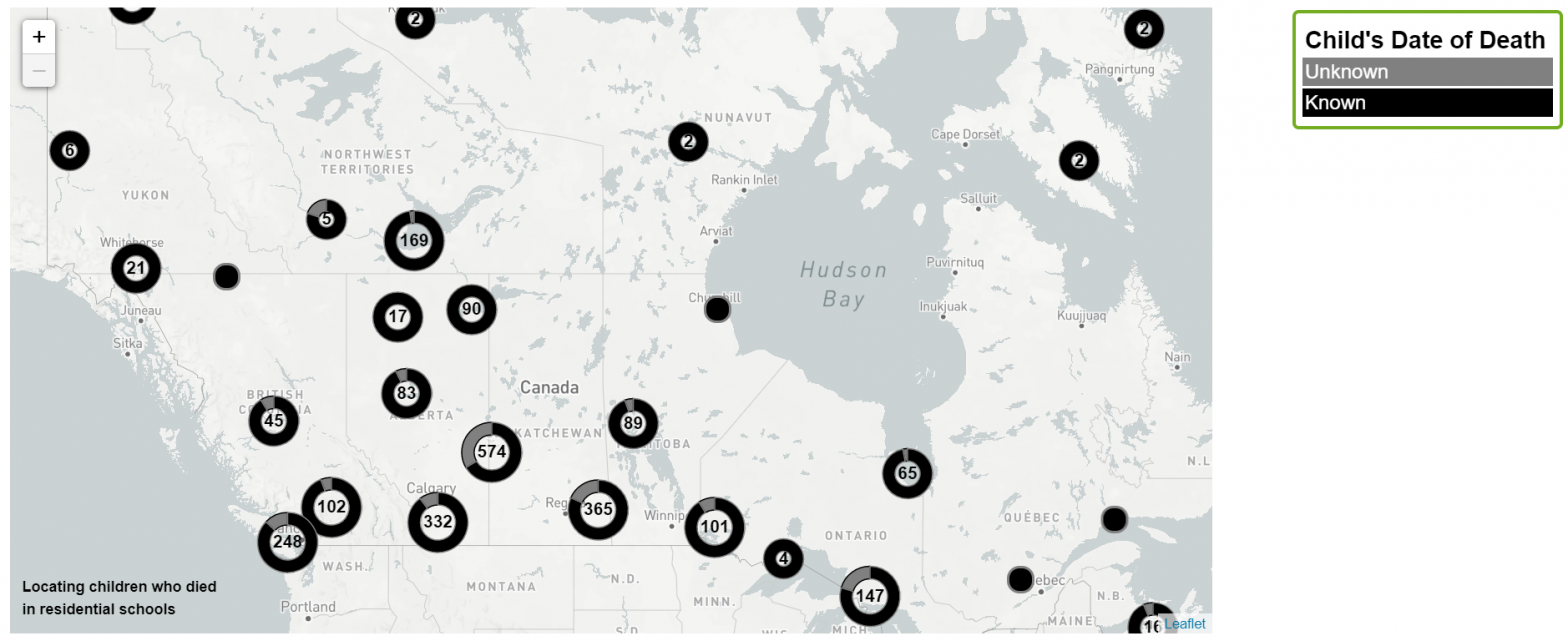The Truth and Reconciliation Commission of Canada
The Truth and Reconciliation Commission of Canada’s “Missing Children and Unmarked Burials Project” was a systematic effort to record and analyze the deaths at the schools within the regulatory context in which the schools were intended to operate. The findings and conclusions included:
- The Commission identified 3,200 deaths on the Truth and Reconciliation Commission’s Register of Confirmed Deaths of Named Residential School Students and the Register of Confirmed Deaths of Unnamed Residential School Students.
- For just under one-third of these deaths (32%), the Canadian government, churches, and schools did not record the name of the child who died.
- For just under one-quarter of these deaths (23%), the gender of the child who died was not recorded.
- For just under one-half of these deaths (49%), the cause of the child’s death was not recorded.
- Aboriginal children in residential schools died at a far higher rate than school-aged children in the general population.
- For most of the history of residential schools, the practice was not to send the bodies of students who died at schools to their home communities.
- For the most part, the cemeteries that the Commission documented were abandoned, disused, and vulnerable to accidental disturbance.
- The Canadian government never established an adequate set of standards and regulations to guarantee the health and safety of children in residential schools.
- The Canadian government never adequately enforced the minimal standards and regulations that it did establish.
- The failure to establish and enforce adequate regulations was largely a function of the Canadian government’s determination to keep the cost of residential schools to a minimum.
- The failure to establish and enforce adequate standards, coupled with the failure to fund residential schools adequately, resulted in unnecessarily high death rates of children in residential schools.
The work that the Commission commenced is far from complete. The National Residential School Student Death Register was the first national report to record the names of the children who died in residential schools. There are many relevant documents that have yet to be reviewed. There are many relevant documents that the Canadian government withheld from the Commission and is still withholding.
The National Centre for Truth and Reconciliation
The National Centre for Truth and Reconciliation at the University of Manitoba is mandated to preserve and continue the work of the Truth and Reconciliation Commission. The mandate includes finding and honouring children who never returned home from residential school.
To this end, the Centre’s website now includes a Memorial Register with the names of children who are known to have died in residential schools. In addition, when a child’s name and place of death is known, the Centre’s website also includes these details (and the child’s date of death, if known) along with a description of the residential school where the child died.
The Centre has also started mapping the history and legacy of residential schools, including the spread of residential schools across Canada over time and the location of the residential schools and the home communities of children who never returned home from residential school.
We wanted to support the Centre by combining its public information about children’s deaths in residential schools with our knowledge of techniques for visualizing data.
Visualization
Our first contribution is an interactive map of children’s deaths in residential schools for the subset of children whose names and places of death are known (fullscreen interactive version):

It’s critical to understand: This map does not represent all children who died in residential schools; their names and numbers will never be known.
Tips for interpreting and interacting with the map:
- You may pan/explore different parts of the map by dragging your mouse across the screen. You may zoom in/out by clicking on the +/- widget in the topleft corner of the screen.
- A clusterpie on the map may represent:
- the children who are known to have died at a single residential school, or
- the group of children who are known to have died somewhere in a cluster of residential schools in that vicinity.
- The number in the centre of a clusterpie indicates the number of children who are known to have died in that vicinity. The black “slices” of a clusterpie represent the proportion of children whose dates of death are known, at least approxately; the white “slices” represent the proportion of children whose dates of death are unknown. Hovering your mouse over a black/white “slice” shows the number of children whose dates of death are known/unknown.
- Clicking on a clusterpie that represents a cluster of residential schools reveals the residential schools included in the original cluster.
- Clicking on a clusterpie that represents a single residential school reveals a set of black and white circles representing individual children who are known to have died there. A black circle represents a child whose date of death at that residential school is known, at least approximately; a white circle represents a child whose date of death is unknown. Clicking on a circles displays a little bit of information about the child and the residential school where she or he died. Clicking on the map closes the display.
There’s lots of room to improve this map and I welcome any offers to help.
Conclusion
The National Centre for Truth and Reconciliation concludes there are many children waiting to be found whose names are not included in the Memorial Register. An extensive amount of work remains to locate and honour the children who never returned home from residential schools.
I hope my effort will help people see more clearly the full extent of the terrible destruction wrought by the Canadian government upon Indigenous children and their families.

This work is licensed under a Creative Commons Attribution-ShareAlike 4.0 International License.
